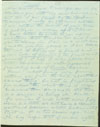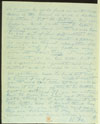Mahatma Letter No. 73
| Quick Facts | |
|---|---|
| People involved | |
| Written by: | Koot Hoomi |
| Received by: | A. P. Sinnett |
| Sent via: | unknown |
| Dates | |
| Written on: | unknown |
| Received on: | August 1882 |
| Other dates: | none |
| Places | |
| Sent from: | unknown |
| Received at: | Simla, India |
| Via: | unknown |
This is Letter No. 73 in The Mahatma Letters to A. P. Sinnett, 4th chronological edition. It corresponds to Letter No. 113 in Barker numbering. See below for Context and background.
< Prev letter chrono
Next letter chrono >
< Prev letter Barker
Next letter Barker >
Page 1 transcription, image, and notes
|
Private. My dearest Friend, Please pardon me for troubling you with my own business — but though I am forced by the Chohan to answer I really do not know whether I am within the limits of your code of politeness or outside of it — I have a long letter to write to you upon something that troubles me and I want you to advise me. I am in a most disagreeable position placed as I am between the risk of betraying a friend and — your code of honour (the friend is not yourself.) I hope I may place an entire confidence in your personal friendship and of course honour. Honour! What funny very funny notions you seem to have about that sacred thing! Do not be frightened for indeed the whole thing is more ludicrous than dangerous. Yet there is a danger in losing Mr. Hume. To-morrow I will write more fully. Fern is a little ass but he is a clairvoyant and likewise a little hallucinated. But Mr. H. is too severe upon him. The boy hopes that if we are myths |
NOTES: |
Page 2
|
or frauds he will find us out. Well where is the harm in such a hallucination? Yet H. betrays his confidence and sends me a letter three yards long with advice how to get out of our difficulties! He wants to be our benefactor and place us under an eternal obligation for saving M. from falling once more into Fern's trap. I would have sent you on his letter but it is superscribed "private and confidential" and I would be in his eyes no gentleman were he find out such a breach of confidence. Well I want you to read this letter at any rate and leave it at your option to be either sent or destroyed. If you do not want him to know you have read it — well put a stamp on it and throw it into the letter-box. I do not think he will take you into his confidence this once. However, I may be mistaken. Soon you will learn more. Yours affectionately, |
NOTES: |
Context and background
Edmund W. Fern was serving as a secretary to Hume and probably living in his home. He was somewhat of a psychic and the Mahatmas considered that he might have some valuable potential for the transmission of messages. He joined the Theosophical Society and was elected secretary of the Simla Eclectic Theosophical Society. The Mahatma M. took an interest in him and accepted him as a chela on probation.
Evidently, Fern annoyed Hume and the latter wrote to the Mahatma K.H. about it and undertook to instruct the Mahatmas as to what they should do about it. His letter to the Mahatma K.H. put the latter in a somewhat embarrassing position.
The Mahatma K.H. answers Hume (in the letter next to be considered) and sends his letter to Sinnett to read before passing on to Hume.
Fern failed his probation later on and was expelled from the Theosophical Society. On August 18 (1882) while Olcott was in Ceylon, he notes: “Night visit from M . . . orders me to expel Fern. Reasons not given. What’s up?” On Dec. 6, Fern himself came to see Olcott and explained certain matters which the Colonel saw necessitated his expulsion. These reasons were not of a psychic nature but concerned business transactions, perhaps in connection with the Simla Eclectic TS. At one time, before Fern’s final failure, the Mahatma M. wrote him a warning letter, apparently the second warning he had given him. (Letters from the Masters of Wisdom, Series II: pp. 142-45)
Physical description of letter
The original is in the British Library, Folio 3. According to George Linton and Virginia Hanson, the letter was written:
On both sides of a single sheet of rippled white paper, 8" X 10 1/2" [20.3 X 26.7 cm], in blue pencil with grained effect. Large lettering.[1]
Publication history
Commentary about this letter
Notes
- ↑ George E. Linton and Virginia Hanson, eds., Readers Guide to The Mahatma Letters to A. P. Sinnett (Adyar, Chennai, India: Theosophical Publishing House, 1972), 135.

